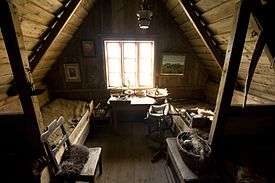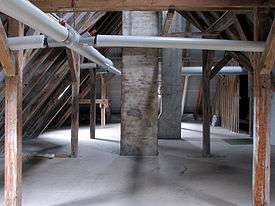Attic

.jpg)

An attic (sometimes referred to as a loft) is a space found directly below the pitched roof of a house or other building; an attic may also called a sky parlor[1] or a garret. Because attics fill the space between the ceiling of the top floor of a building and the slanted roof, they are known for being awkwardly shaped spaces with exposed rafters and difficult-to-reach corners.
While some attics are converted into bedrooms, home offices, or attic apartments complete with windows and staircases, most remain difficult to access (and are usually entered using a loft hatch and ladder). Attics are generally used for storage, though they can also help control temperatures in a house by providing a large mass of slowly moving air. The hot air rising from the lower floors of a building is often retained in attics, further compounding their reputation as inhospitable environments. However, in recent years attics have been insulated to help decrease heating costs, since, on average, uninsulated attics account for 15 percent of the total energy loss in average houses.[2]
A loft is also the uppermost space in a building but is distinguished from an attic in that an attic typically constitutes an entire floor of the building, while a loft covers only a few rooms, leaving one or more sides open to the lower floor.
Etymology
The word "attic" is derived from the Attica region of Athens, Greece, and comes from Attic style architecture. The term referred to "a low decorative facade above the main story of a building" and, as used in the phrase "attic order",[3] had originally indicated a small decorative column above a building's main facade.[4]
Ventilation
Modern building codes require unoccupied attics to be ventilated[5] to reduce the accumulation of heat and moisture that contribute to mold growth and decay of wood rafters and ceiling joists.
One common code requirement is that the total area of attic vents be equal to or greater than 1/150 of the floor area of the attic, with 50 percent or more of the vent area located in the upper portion of the attic. Various types of turbine ventilators and exhaust fans can also be used to assist with attic ventilation and decrease the required area of passive ventilators.
In popular culture
In American popular culture, attics are often associated with an accumulation of old items, especially consumer goods, heirlooms, junk, and sometimes hoarding. They are also a recurring theme in folklore, horror fiction, portrayals of clandestine (especially teenage) relationships, and as a comedic trope of several varieties.
In "Treehouse of Horror VII," the first episode of the eighth season of The Simpsons, an evil twin is kept secretly chained within the confines and seclusion of the family's attic. After many years, he is discovered by the other children in the home, who are terrified by the dark and seemingly foreign space in their home.
See also
References
- ↑ Kilborne, Sarah S. (2012). American Phoenix: The Remarkable Story of William Skinner, A Man Who Turned Disaster Into Destiny. New York: Simon and Schuster. p. 146. ISBN 978-1-4516-7179-7.
- ↑ Attic Insulation retrieved 2016-10-24
- ↑ Skeat, Walter W. (1993). The Concise Dictionary of English Etymology. Hertfordshire, UK: Wordsworth Editions. p. 22. ISBN 978-1-85326-311-8.
- ↑ "attic" (etymology). etymonline.com
- ↑ International Code Council (2015). 2015 International Building Code Illustrated Handbook. New York: McGraw-Hill Education. pp. 506 (Section 1203.2). ISBN 978-1-259-58613-2.
External links
 Media related to Attics at Wikimedia Commons
Media related to Attics at Wikimedia Commons